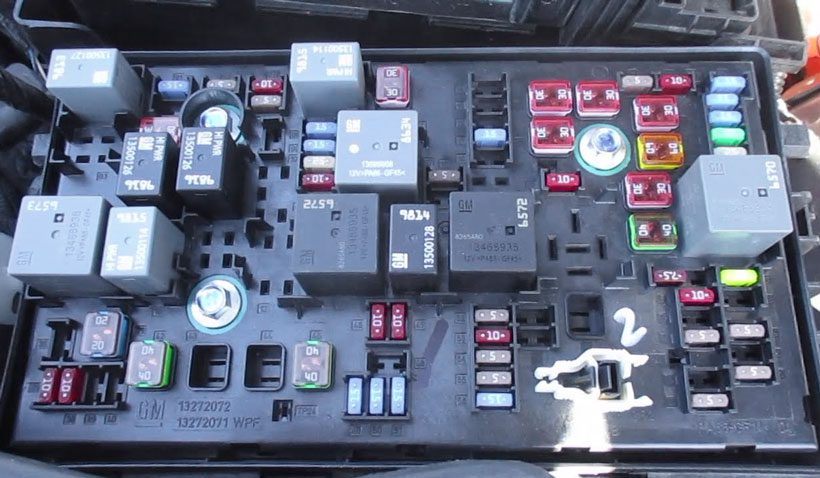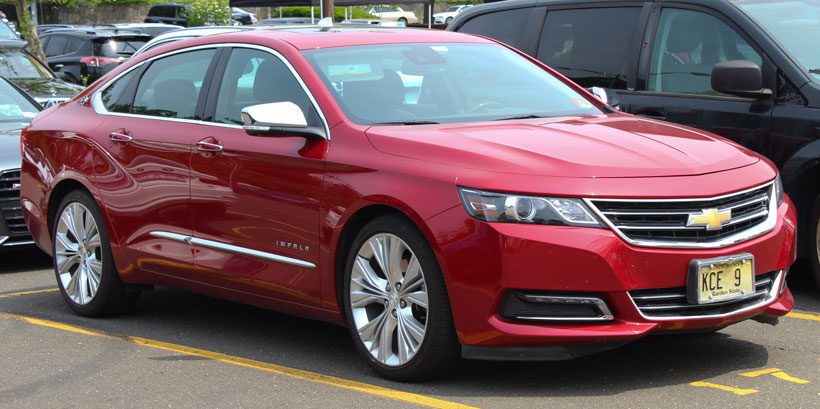Chevy Impala ABS Light On: Causes and Resetting Solutions
You surely have an ABS warning light on your dash if you own a Chevy Impala with an ABS or anti-lock braking system. The system prevents the locking up of your car wheels when you break. And the ABS light on your dash will come on if the system fails to function optimally.
So, what causes the Chevy Impala ABS light on? In most cases, a faulty or dirty ABS sensor triggers the ABS light. Blown-out ABS fuse, malfunctioning control module, and leaks in the ABS pump can also be the culprit. Besides, the ABS light will turn on if your brake pads have worn down and the tire pressure is low.
Let’s dive in and find out the causes and possible fixes for the illuminated ABS light issue.
Why Is the ABS Light On In My Chevy Impala? – Potential Fixes
The ABS has multiple working components including the ABS sensors, control module, fuse and wires, ABS pump, etc. If any of these parts are damaged or malfunctioning, the ABS light will be triggered.

Below are the most common reasons why the ABS light is on in your Chevy:
1. Corroded ABS Sensors
From our experience with the users, we’ve seen those corroded or faulty ABS sensors are usually the root of the warning light issue. The ABS or wheel speed sensors monitor the rotational speed and condition of the car wheels.
It’s a small metal component attached to a long cable and placed on your wheel’s hub.
Over time, the sensor gets rusty or corroded due to exposure to various environmental factors. As a result, the sensors fail to monitor the wheel speed. Consequently, the system malfunctions and this triggers the ABS light.
Potential Fix
If it’s only dirt or grime that’s blocking the ABS sensors, removing the dirt will solve the issue. However, when the sensor is fully corroded, you need to replace it with a new one. Here’s the process of replacement.
- First things first, remove your car battery to ensure maximum safety
- Lift the car at a suitable height so that you can easily access the wheel
- As mentioned, you’ll find the ABS sensors close to your brake caliper mounted on the wheel hub. To remove the sensor from its mounting hole, unplug all the electrical connectors from each end of the sensor. Remove all the mounting nuts that attach the sensor to the wheels
- Once you’ve disconnected all the cables, connectors, and retaining clips, you can take out the damaged sensor without any interference
- After that, place the new sensor on the mounting hole and ensure proper alignment
- Connect all the cables, clips, and connectors to the new sensor just as they were with the previous one
- When you’re done, put your car battery back in its place and see if the ABS light has turned off
Check out this video in case you need some visual aid.
2. Faulty ABS Control Module
Another common reason why the ABS light comes on is a faulty ABS module. The ABS control module processes the data provided by the sensors and other parts of the system. It provides the information to the central computer of the car and displays the readings on the speedometer.
If your ABS module is faulty, it won’t process the data and the computer will set a trouble code for this. Therefore, the ABS light on your dash will be triggered.
In this case, you might get the Code U0121 which describes trouble communicating the ABS module.
Potential Fix
As the control module is a complex component of the system, you must take it to an expert mechanic to replace it. But first, you can try out a few methods to see if the control module needs a replacement. Here’s what you can do-
- Sometimes resetting the ABS can help you solve the warning light issue. For this, disconnect your car battery and press your brake pedal for 5 seconds. This way, the electric system will be drained and the ABS will reset
- In case the reset didn’t help, you can use an OBD-II scan tool and erase the DTC codes such as C1233, C0070, C0040, etc., for the ABS
3. Blown ABS Fuse
To provide continuous readings of the wheel’s rotation and speed, the ABS requires a stable power supply. Hence, the system relies on a number of wires and fuses to ensure a secure route for the electricity.
The ABS fuses are highly sensitive, so they can easily get damaged by electricity overflow. As a result, the whole system might fail and the ABS light comes on.

Potential Fix
In this case, all you have to do is locate the blown fuse and replace it with a new one. Below are the details-
- Typically, the fuse box of a Chevy Impala is located inside the hood near the engine compartment. However, the location of the fuse box might vary depending on the manufacturing year. So, refer to your owner’s manual to know the exact location
- Now, locate the ABS fuse and see if there’s any sign of damage. Take help from the fuse diagram if necessary
- Once you’ve found the blown fuse, remove it with needle-nose pliers. Install a new fuse with the same ampere rating and your job is done!
4. ABS Pump Leaks
For smooth braking, the ABS pump maintains the correct pressure in the brake system. It also ensures proper operation of the ABS and brake system. If there is a leak in the pump or its associated components, it can cause a pressure drop.
When your Chevy’s central computer detects the pressure drop, it will trigger the ABS warning light.

Potential Fix
If you suspect there’s a leak in the ABS pump or its related parts, follow these steps-
Step 1: Inspect the ABS pump, brake lines, hoses, and other components of the ABS. It will help you identify the specific area where the leak is occurring
Step 2: Get the leak fixed by an expert mechanic. Although the leaked area can be patched, it’s best to replace the faulty component to avoid the ABS light issue in future
Step 3: Replace your car’s brake fluid or top off the reservoir if the system has lost brake fluid due to the leak
5. Worn Brake Pads
If your Chevy’s brake pads are worn down, it will create issues like uneven braking and loss of hydraulic pressure. As the ABS ensures smooth and safe braking, worn brake pads can affect the system and cause the ABS to light.
Apart from the brake pads, the brake calipers and other related components can also affect the braking and trigger the ABS.
Potential Fix
To fix this issue, you need to locate and replace the worn brake pads. Here’s the process-
- To access the brake pads on your rear wheels, remove your car wheel and the brake caliper
- Once you locate the brake pads, visually inspect them for signs of damage and corrosion
- If the brake pads look worn, you need to replace them. For this, use a screwdriver to take off the retaining clips that hold the brake pads in place
- Once the clips are removed, you can easily pull the worn brake pads out
- Install the new ones in their designated mounting place and fasten them with the retaining clips. When the new brake pads are aligned, the task is done
6. Low Tire Pressure
As the ABS of your Chevy Impala is directly connected to the wheels, the change in wheel pressure can trigger the ABS light. When the pressure becomes lower than standard due to a puncture, the tire circumference is reduced.
As a result, the damaged tire can spin faster than the other three tires. The ABS control module detects the change and the warning light comes on.

Potential Fix
If the ABS light is on due to low tire pressure, you’ll notice the Tire Pressure Monitoring System (TPMS) light has also been turned on. To fix this issue-
- Patch your deflated tire and make sure the tire pressure is at the standard level. Refer to your owner’s manual to check what’s the optimal tire pressure required for your Chevy
- In case the tire isn’t fixable, you need to replace it with a new one. Contact your dealership to get a replacement that perfectly fits your wheel rims
FAQs
Got more queries? Let’s address some common questions regarding the ABS of your Chevy Impala.
Typically, the only way to fix the ABS nodule is to replace it. The replacement cost can range from $320 to $1,000 or more. You need to pay $672-$716 for the replacement. You’ll have to pay for the new ABS module and related parts. The mechanic might also charge you separately for diagnosis.
Yes, you can drive with an illuminated ABS light, but it’s not recommended. The ABS light indicates issues with the anti-lock system. So, if you drive with a lit ABS light, you can still brake manually although the brake performance will not be optimal.
The ABS sensors constantly monitor the rotational speed of your car wheels. If any wheel slip or skidding is detected, the wheel sensors send signals and the ABS module processes it. The module releases the hydraulic valves and restores the pressure on the brake pads.
By momentarily reducing brake pressure, the ABS allows the wheel to rotate again, preventing it from locking up.
Final Words
So, now you know all the necessary details about the Chevy Impala ABS light on issue. To get to the root of this issue, check and replace your Chevy’s ABS sensors. Inspect the system for a faulty control module, blown fuses, and worn brake pads.
Sometimes leaks in the ABS pump can also turn on the ABS light. If you’ve any previous experience repairing automotive parts, you might be able to fix the system by yourself. However, we recommend consulting a professional or your dealership for proper diagnosis and fixing.

